I planted my first sunflowers aged 0.5 years, admittedly with a bit of help, and there’s a strong possibility I wouldn’t be where I am today without growing sunflowers. When you learn how to grow sunflowers, it becomes an annual habit, and a year without them is a year wasted.
I adore their joyful and inquisitive heads that turn to follow the sun over the horizon through the day and get limitless joy from watching the birds ravage their seed-filled centres over autumn and winter.
In this article, I want to share how, and when to plant sunflowers, and how to make the most of every different variety in your own garden.
More...

Genus: | Helianthus |
|---|---|
Common Name: | Sunflower |
Family: | Asteraceae |
Location: | Outdoor |
Type: | Annual and perennial flowering plants |
Growth: | 6 ft. on average |
Sun requirements: | Full sun |
Foliage Colour: | Green |
Flower Colour: | Yellow, orange, red |
Flowering: | Summer |
Fruit: | None (but plenty of edible seeds) |
Maintenance level: | Medium, regular watering |
Poisonous for pets: | Non-toxic to cats and dogs |
What is a Sunflower?
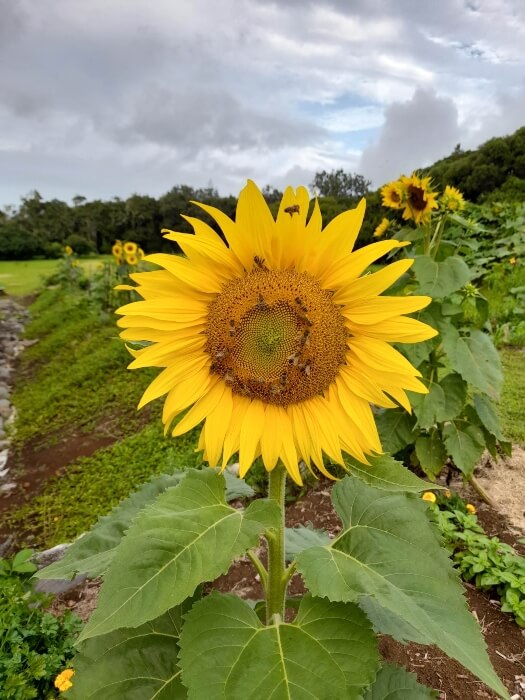
Sunflowers, or Helianthus, are a genus containing over seventy species of flowering plants, including a handful of perennial plants, and edible tubers.
There are two traits that give this plant it's name. One is their distinct likeness to a full summer sun, with rays of brightly coloured petals encircling the centre of the seed head.
The other is perhaps less well known; sunflowers turn their heads through the day to follow the sun's light in order to boost their essential oils and nectar production and attract more pollinators.
For wildlife gardening, sunflowers are excellent natural bird feeders, with sturdy stems that even bigger birds can get a hold of and peck away at the fatty, protein-rich seeds.
Sunflower’s Natural Habitat
All apart from three varieties of Helianthus are native to North America, with three varieties found growing wild in South America that have evolved to cope with hotter temperatures and higher rainfall.
Sunflowers need wide open spaces to thrive, and those iconic images of fields full of sunflowers, grown for cut flowers, just as often as for their oil, are the perfect example of how these beautiful towering yellow plants grow in their natural environment.
(Speaking of cut flowers, be sure to check out our growing guide on Hippeastrum which is one of our favourite cut flower.)
Admittedly, neat rows of thousands of sunflowers won’t happen in the wild, as they fight against prairie plants and weeds to survive, but they stand tall over fields of flowers getting every drop of sunlight they can, with widespread but fine roots that drink up every inch of rainfall they can get their hands on.
Types of Sunflowers
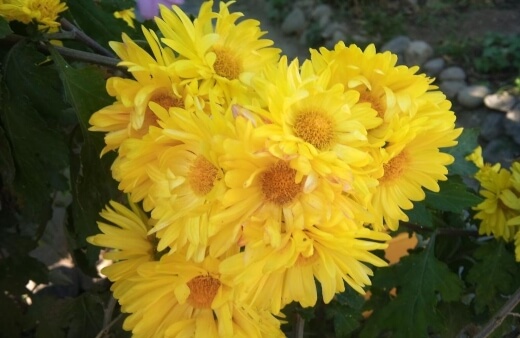
Annual Sunflowers
52 out of around 70 species of sunflower are annual, meaning they grow from a seed to a 6ft tall plant in a single year, and then die back leaving just their seeds behind in winter.
The most common annual sunflower is Helianthus annuus, which the vast majority of garden plants are cultivated from, using lesser-known species.
All annuals grow in near-identical conditions, requiring rich reasonably-well-draining soil, plenty of water, and full sun.


Get Your Free Guide:
Master Growing Australian Natives eBook
A Must Have Complete Guide for Every Australian Garden
Get Your Free Guide:
Master Growing Australian Natives eBook
A Must Have Complete Guide for Every Australian Garden
Perennial Sunflowers
While we all know and enjoy sunflower seeds, some perennial varieties like the Jerusalem Artichoke (Helianthus tuberosus) have edible root tubers that have dozens of culinary applications.
Perennials, including artichokes spread through their seeds, and from tuberous roots, which multiply underground, so need regular thinning in the garden as they can easily get out of control in perfect conditions.
Also read: Full list of edible flowers you can grow in Australia.
Popular Sunflowers to Grow in Australia
1. Sunflower SunFill Green
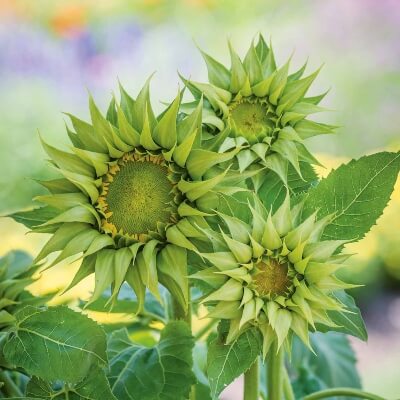
Source: marshallsgarden.com
Sun fill green is one of the many cultivars of H. annuus, the common annual sunflower. Grown for its striking green petals, with occasional flashes of orange as the seed ripens, these short sunflowers are great for flower arranging and produce mountains of seeds for harvest, or for wildlife.
2. Sunflower Claret (Helianthus annuus ‘Claret’)

H. annuus ‘Claret’ is one of the deepest reds you can find in the sunflower world, sticking out of any garden border like a giant ruby.
Interestingly, the leaves of H. annuus ‘Claret’ are deeply affected by watering, producing gorgeous silvery foliage on slightly purple stems in sandier soils, and lush green plants in rich well-watered compost.
3. Sunflower Teddy Bear (Helianthus annuus ‘Teddy bear’)

H. annuus ‘Teddy bear’ are one of those plants that doesn’t really need explaining. These pom pom shaped sunflowers might not be great for wildlife, with their closed flower heads, and limited seed production, but they are utterly adorable additions to patio containers or the front of borders where they are a striking edge to any path.
4. Sunflower Vanilla Ice (Helianthus debilis ‘Vanilla Ice’)

If you need an illustration of the difference between H. annuus, and other sunflower species, look no further than H. debilis. H. debilis is a species of multi-stemmed sunflowers, with multiple flowers on each plant.
Vanilla ice is one of the most readily available H. debilis sunflowers in garden centres and online, with pale, creamy flowers that shine out from the garden as the sun goes down in the evening.
5. Sunflower Red Sun (Helianthus annuus ‘Red Sun’)
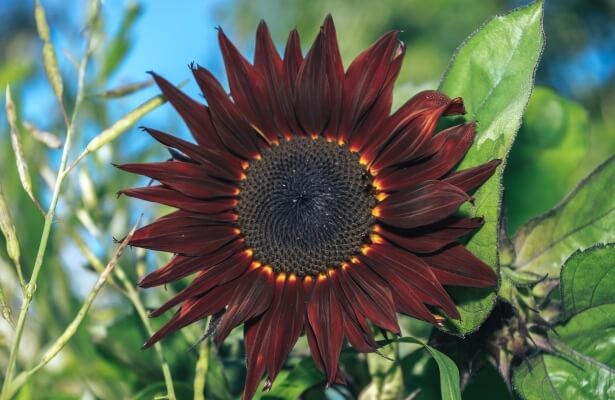
H. annuus ‘Red Sun’, is somehow brighter, and softer than other red sunflowers all at once. The passionate scarlet flowers have delicately overlapped petals with gently rounded tips, growing to just under 6ft tall.
For a more delicate poop of red in the border that doesn’t take much effort, these are a great alternative to Claret, or even a good replacement for more dominating shrubs.
6. Sunflower Pacino Gold (Helianthus annuus ‘Pacino gold’)
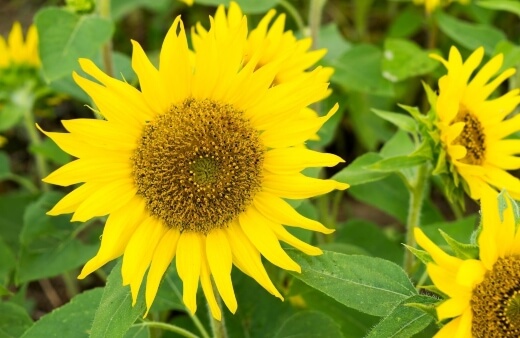
H. annuus ‘Pacino gold’ is typically sold as multi-headed sunflowers but grows best when pinched out to produce single-flowered plants. By deadheading spent flowers, they will produce new flower heads in a couple of weeks, prolonging their flowering period slightly.
7. Sunflower Double dazzler (Helianthus annuus ‘Double dazzler’)
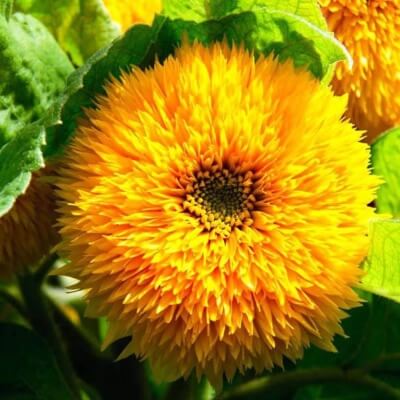
Source: australianseed.com
‘Double dazzler’ is unusual for H. annuus, in that it is capable of growing multi-flowered stems. The initial flower head blooms in early summer, and as that head is pollinated, smaller pom pom like sunflowers appear just below it, providing even more seeds for harvest.
8. Sunflower Giant Russian (Helianthus annuus ‘Giant Russian’)
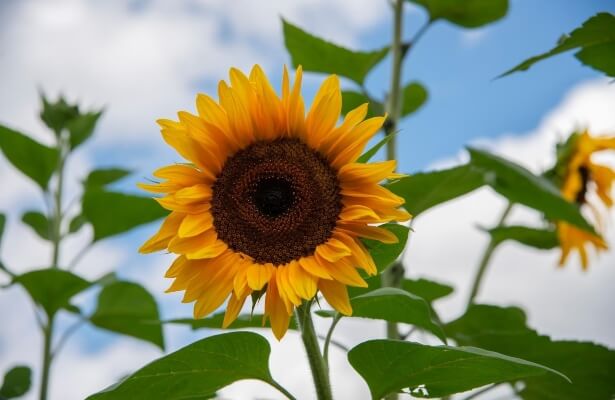
At the start of this article, we suggested that sunflowers typically grow to around 6ft tall, and we stand by that, but H. annuus ‘Giant Russian’ can reach over 10ft tall, towering over any gardener, and producing flowers that will blow visitors away with their immense height.
As well as tall stems, they boast flower heads well over 30cm across, making them incredibly good bird feeders, and great for harvesting sunflower feeds into autumn.
9. Sunflower ProCut Plum (Helianthus annuus ‘ProCut Plum’)

Source: osborneseed.com
We’ve never grown pro-cut plum, but it’s been on our list for a few years now, with gorgeous peachy petals, fading out from a rich burgundy centre.
H. annuus ‘ProCut Plum’ typically reach around 4ft tall, so they’re perfect for a mixed annual border, but they can reach up to 6ft in ideal conditions.
10. Jerusalem Artichoke (Helianthus tuberosus)
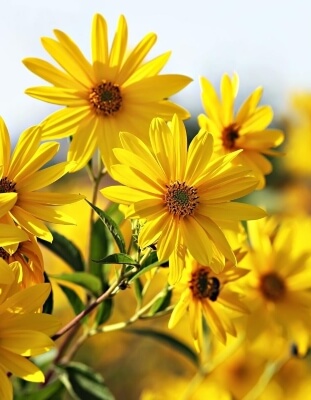
The infamous edible sunflower, produces plentiful edible tubers with a completely unique flavour. Their tubers can be fried, baked, boiled or mashed, just like potatoes, and as long as you leave one or two tubers in the ground each year, they’ll reproduce and come back every single year.
11. Sunflower Italian White (Helianthus annuus ‘Italian White’)
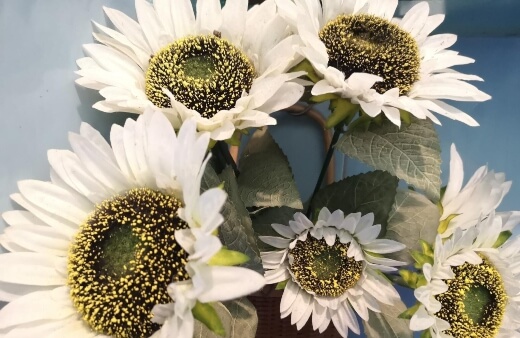
The Italian white sunflower sparks visions of rolling vineyards, lined with white sunflowers, but of course, these sunflowers are man-made cultivars of the common H. annuus, native to America.
However these beautiful white sunflowers got their name, they scream of Italian countryside, and add a touch of the Mediterranean to any garden.
12. Thinleaf Sunflower (Helianthus decapetalus)
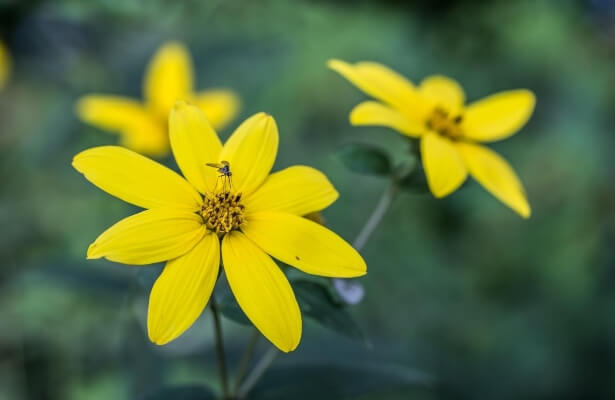
The wild perennial sunflower is native to North America and grows happily even in cooler parts of Canada, so can cope well with colder parts of Australia, and will almost always return for six or seven years before you need to consider dividing it.
These gorgeous wildflowers bear such a small resemblance to H. annuus that it’s hard to believe they’re in the same family, but they make excellent additions to low maintenance gardens.
13. Silverleaf Sunflower (Helianthus argophyllus)
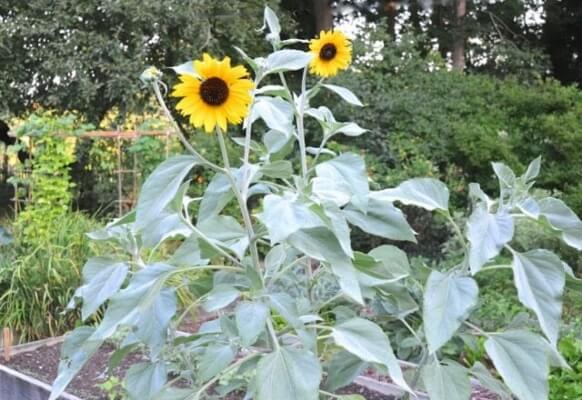
Source: awaytogarden.com
Not only is the silver leaf sunflower one of the closest likenesses to its annual cousin’s flowers, but it has the benefit of being reliably multi-headed, with at least half a dozen flowers per stem.
The big selling point of these low maintenance, annual sunflowers though, is their unique silvery foliage, making them look like Mediterranean or even alpine plants.
1. Sunflower ‘SunFill Green’ SunFill green is one of the many cultivars of H. annuus, the common annual sunflower. Grown for its striking green petals, with occasional flashes of orange as the seed ripens, these short sunflowers are great for flower arranging and produce mountains of seeds for harvest, or for wildlife. |  Source: marshallsgarden.com |
2. Sunflower Claret (Helianthus annuus ‘Claret’) H. annuus ‘Claret’ is one of the deepest reds you can find in the sunflower world, sticking out of any garden border like a giant ruby. Interestingly, the leaves of H. annuus ‘Claret’ are deeply affected by watering, producing gorgeous silvery foliage on slightly purple stems in sandier soils, and lush green plants in rich well-watered compost. |  |
3. Sunflower Teddy Bear (Helianthus annuus ‘Teddy bear’) H. annuus ‘Teddy bear’ are one of those plants that doesn’t really need explaining. These pom pom shaped sunflowers might not be great for wildlife, with their closed flower heads, and limited seed production, but they are utterly adorable additions to patio containers or the front of borders where they are a striking edge to any path. |  |
4. Sunflower Vanilla Ice (Helianthus debilis ‘Vanilla Ice’) If you need an illustration of the difference between H. annuus, and other sunflower species, look no further than H. debilis. H. debilis is a species of multi-stemmed sunflowers, with multiple flowers on each plant. Vanilla ice is one of the most readily available H. debilis sunflowers in garden centres and online, with pale, creamy flowers that shine out from the garden as the sun goes down in the evening. |  |
5. Sunflower Red Sun (Helianthus annuus ‘Red Sun’) H. annuus ‘Red Sun’, is somehow brighter, and softer than other red sunflowers all at once. The passionate scarlet flowers have delicately overlapped petals with gently rounded tips, growing to just under 6ft tall. For a more delicate poop of red in the border that doesn’t take much effort, these are a great alternative to Claret, or even a good replacement for more dominating shrubs. |  |
6. Sunflower Pacino Gold (Helianthus annuus ‘Pacino gold’) H. annuus ‘Pacino gold’ is typically sold as multi-headed sunflowers but grows best when pinched out to produce single-flowered plants. By deadheading spent flowers, they will produce new flower heads in a couple of weeks, prolonging their flowering period slightly. |  |
7. Sunflower Double dazzler (Helianthus annuus ‘Double dazzler’) ‘Double dazzler’ is unusual for H. annuus, in that it is capable of growing multi-flowered stems. The initial flower head blooms in early summer, and as that head is pollinated, smaller pom pom like sunflowers appear just below it, providing even more seeds for harvest. |  Source: australianseed.com |
8. Sunflower Giant Russian (Helianthus annuus ‘Giant Russian’) At the start of this article, we suggested that sunflowers typically grow to around 6ft tall, and we stand by that, but H. annuus ‘Giant Russian’ can reach over 10ft tall, towering over any gardener, and producing flowers that will blow visitors away with their immense height. As well as tall stems, they boast flower heads well over 30cm across, making them incredibly good bird feeders, and great for harvesting sunflower feeds into autumn. |  |
9. Sunflower ProCut Plum (Helianthus annuus ‘ProCut Plum’) We’ve never grown pro-cut plum, but it’s been on our list for a few years now, with gorgeous peachy petals, fading out from a rich burgundy centre. H. annuus ‘ProCut Plum’ typically reach around 4ft tall, so they’re perfect for a mixed annual border, but they can reach up to 6ft in ideal conditions. |  Source: osborneseed.com |
10. Jerusalem Artichoke (Helianthus tuberosus) The infamous edible sunflower, produces plentiful edible tubers with a completely unique flavour. Their tubers can be fried, baked, boiled or mashed, just like potatoes, and as long as you leave one or two tubers in the ground each year, they’ll reproduce and come back every single year. |  |
11. Sunflower Italian White (Helianthus annuus ‘Italian White’) The Italian white sunflower sparks visions of rolling vineyards, lined with white sunflowers, but of course, these sunflowers are man-made cultivars of the common H. annuus, native to America. However these beautiful white sunflowers got their name, they scream of Italian countryside, and add a touch of the Mediterranean to any garden. |  |
12. Thinleaf Sunflower (Helianthus decapetalus) The wild perennial sunflower is native to North America and grows happily even in cooler parts of Canada, so can cope well with colder parts of Australia, and will almost always return for six or seven years before you need to consider dividing it. These gorgeous wildflowers bear such a small resemblance to H. annuus that it’s hard to believe they’re in the same family, but they make excellent additions to low maintenance gardens. |  |
13. Silverleaf Sunflower (Helianthus argophyllus) Not only is the silver leaf sunflower one of the closest likenesses to its annual cousin’s flowers, but it has the benefit of being reliably multi-headed, with at least half a dozen flowers per stem. The big selling point of these low maintenance, annual sunflowers though, is their unique silvery foliage, making them look like Mediterranean or even alpine plants. |  Source: awaytogarden.com |
How to Grow Annual Sunflowers
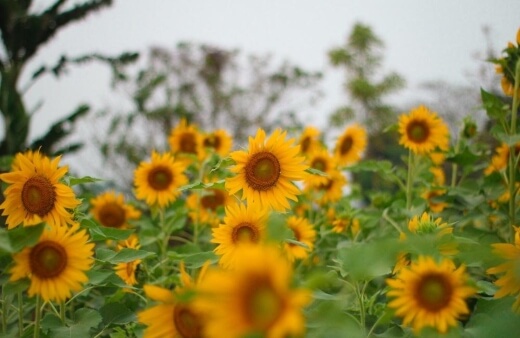
Annual Sunflowers Propagation
Annual sunflowers, mostly cultivars of Helianthus annuus, grow in the same conditions, and should all be sown in the last few weeks of spring. They are fast-growing, so can reach 6ft in just 3 months from seed so don’t be tempted to sow them too early.
In the guide below we’ll talk about how to sow sunflowers.
How to Propagate Annual Sunflowers from Seed
To propagate from seed, you’ll need a good free draining compost mix. Using a shop-bought seed compost is the safest bet, but to mix your own, use sieved garden compost, perlite, and sieved topsoil in equal parts. This provides nutrients and drainage without overstimulating seeds.
Sunflower seeds with easy access to nutrients can grow too quickly and develop long, thin, leggy stems that won’t do well when planted out in the garden.
To get sunflower seeds started indoors, or in seed trays in the garden:
- Prepare a seed module tray with a seed potting mix.
- Push sunflower seeds 2cm deep into the soil (it doesn’t matter what side is up).
- Water well.
- Leave in a sunny spot, either on a windowsill, greenhouse or in full sun outside in late spring.
- Water every few days, or whenever the soil is starting to dry out.
Alternatively, you can sow your sunflower seeds directly in the garden bed. Follow the instructions above by planting them between 30 and 60cm apart, and cover them with 2cm of compost.
Mark their position with a bamboo cane so you don’t accidentally disturb them before germination.
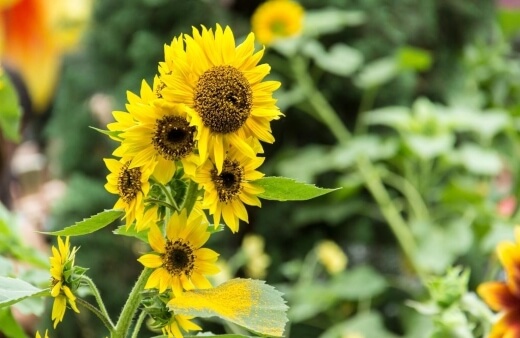
Potting on and Planting Out Annual sunflowers
If you used the first method above, and sowed in seed modules, wait until they have roots showing out of the base of each module, then carefully pop them out of their containers (handling them with a leaf, not a stem), and put them into the ground so the soil level in the pot is 1-2cm below the soil surface. This gives them some extra stability in the garden.
Water your seedlings well, and keep them moist now for the next few months until flowering.
Caring for Annual Sunflowers
Sunflowers will grow happily outdoors in every single part of Australia, thanks to the warmer climate than their natural habitat scattered across the United States.
While they would germinate naturally in late spring, here we can start them slightly earlier, and benefit from their bright blooms for even longer as sunflowers hold their flowers until they are completely pollinated.
Watering Annual Sunflowers
They can cope with short periods of drought, but drought coupled with the hot Australian summers can cause leaves to wilt. If you notice wilting leaves, water sunflowers straight away.
They will visibly recover within an hour or so thanks to their fast metabolism. In general, this plant will do better in soils with good water retention, but not in damp conditions.
Before planting, mix some compost through any sandy soils to help water retention, and mulch sunflowers when they reach 2 ft. tall. This stops their roots from drying out, and gives them some support against the wind too.
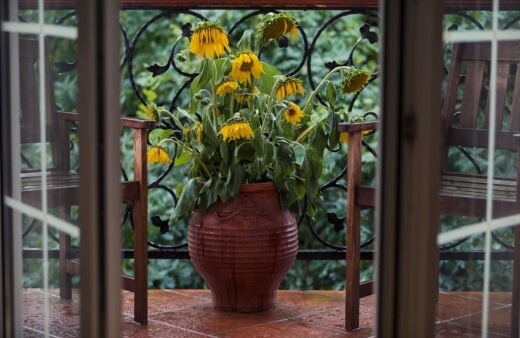
Annual Sunflower Sun Requirements
This plant need full sun. The clue’s in the name. Sunflowers will grow in shade but usually grow tall and thin with disappointing flowers as they rush upwards in search of sun that isn’t there.
While full sun might sound challenging, in gardening terms, it means 6+ hours of bright, or direct sunlight per day. So look for a good spot that gets plenty of light in the afternoon.
Soil & Compost for Annual sunflowers
Annual sunflowers are heavy feeders, like all annual plants, so give them as many nutrients as possible at the planting stage. Mix rich garden compost through the soil, or even mix a trench of well-rotted manure under where you plan to plant them so their roots can go down in search of nutrients.
(Make your own compost using the best worm farms we have reviewed for 2024.)
Sunflowers prefer slightly acidic soils with a pH of around 6, meaning they will grow happily in most Australian gardens with an average pH between 5.5 and 7.
What Fertiliser to Use
If you’ve already planted your sunflowers, and it’s too late to mulch them, tomato feeds are brilliant for sunflowers to develop healthy flowers and an abundance of seeds.
Tomato fertilisers are rich in Phosphorus and potassium, which helps develop flowers and fruits, so are a great multiple purpose feed for a garden full of annual flowering plants like sunflowers.
Read our Complete Australian Garden Fertiliser 2024 Users Guide to learn about different types of fertilisers and what plants it works best.
Staking Sunflowers
In windy areas or coastal locations, you should stake your sunflowers. Healthy sunflowers can hold up heavy seed heads without any support if they are protected from the wind but should be staked with simple bamboo canes before they flower if they are at all exposed to the wind.
How to Harvest Sunflower Seeds

Sunflower seeds are a brilliant snack, and really simple to harvest. When the flower finishes in late summer, avoid the temptation to cut it off. Leave it on the stem to dry, and protect it from birds, and you’ll have a great stash of protein-rich, nutty seeds to treat yourself in autumn.
Sunflower seeds ripen best on the plant, so to harvest:
- Make sure your sunflower is pollinated. When they begin to flower, brush over the entire centre with a fine paintbrush.
- Continue watering right through their flowering period, and for a week after the flowers die back.
- Stop watering when the seeds are noticeable, then leave the plant to feed itself and dry out its seed head.
- At this point, seeds are very attractive to birds and small mammals, so wrap netting over the head of your sunflowers to protect them from wildlife.
- After 2-3 weeks you should have a bountiful crop of sunflower seeds. Simply cut off the head, and rub over the seeds. They’ll just fall out onto the table.
- Leave them on a sunny windowsill for a day or two to dry out, then put them in a jar for storage.
Sunflower seeds are great for wildlife too, so if you’d prefer to leave sunflower seeds out for wildlife, without looking at the dead flower heads, wait for a week after the flowers died back, then cut off the heads, and hang them upside-down by your bird feeding station.
Growing Perennial Sunflowers
There are around twenty varieties of perennial sunflowers, all growing on tuberous root systems that come back every year, but by far the most commonly grown by gardeners is the Jerusalem artichoke, which makes wonderfully earthy, slightly fragrant chips that fry beautifully, and roast even better.
Even those perennial sunflowers that aren’t grown as a crop are a great way to create a bright and flower-filled low-maintenance garden, with striking sunflowers year after year.
Planting Perennial Sunflowers

Perennial Sunflowers Propagation from seed
Most perennial sunflowers are grown from tubers, but they produce seeds just like any other sunflowers. For best results, sow seeds directly in the garden in late spring, water them well, and wait for them to sprout.
When perennial sunflower seeds sprout, stake them with bamboo so you don’t step on them, and let them flower, and die back entirely in their first year.
The second year’s growth will develop edible tubers that can be dug up in mid to late autumn and kept cool and dry for up to two months before eating.
How to Propagate Perennial Sunflowers from Root Cuttings
Helianthus tuberosus grow from underground tubers, and spread easily through the garden in loose soils, usually producing half a dozen new tubers from each plant every year. Thankfully they are easy to control, but also, very easy to propagate.
Store the previous year’s tubers in a cool, dry, dark place through winter, and simply replant those 10cm deep in loose compost in spring to make a new patch of perennial sunflowers (or buy tubers from your local garden centre in spring).
How to Care for Perennial Sunflowers
Perennial sunflowers have thinner stems than annual sunflowers, relying more on the deep, thick, roots to support them against the wind. That doesn’t mean they need fewer nutrients though and should be given plenty of water, full sun, and nutrient-rich, free-draining compost so they are never sat in the water, just like their annual cousins.
The only difference between annual sunflower and perennial sunflower care is that perennial sunflowers rarely need staking as they grow in tight clumps, they require a more balanced fertiliser, and their roots require nitrogen to develop.
Either feed with a balanced liquid fertiliser once every two weeks, or mulch tubers every year in winter with well-rotted manure.
Sunflowers Pests and Diseases

In their natural habitat, sunflowers have a whole host of pests, including the sunflower beetle, sunflower moths, and stem maggots.
However, the only real threats to sunflowers in Australia are cutworms and grasshoppers, but neither typically cause enough harm to be concerned about unless growing for agricultural use.
Most sunflower diseases are related to high humidity, and damp leaves, so avoid planting sunflowers near spray irrigation systems where they can be accidentally misted in the evenings by sprinklers, causing standing water on their leaves.
Mildew
There are two types of mildew that affect sunflowers:
- Powdery mildew
- Downy mildew
Powdery mildew affects sunflowers like every other soft left annual, and looks almost identical to powdery mildew in courgettes and tomatoes, with an even covering of powdery white patches, appearing on the lower leaves and slowly spreading up the plant.
Downy mildew is a more cottony surface covering across young plants, with fungal spores than can live in the soil for up to ten years afterwards.
For both types of mildew, treat the plant, and the soil with diluted neem oil (an organic fungicide).
Leaf Blight
Like mildew, blight comes in multiple forms, but sunflowers in Australia are commonly affected by both Alternaria leaf blight and phoma blight.
Alternaria blight creates dark brown lesions on leaves, surrounded by yellow haloes, usually caused by funguses that are encouraged by water sitting on leaves (similar to mildew’s causes).
Phoma blight tends to occur after flowering, and looks more like tomato or potato blight, with large black legions grouping together on the stem, and releasing a cloud of spores when touched.
If either blight occurs, it’s best to carefully place a plastic bag over the entire plant, pull it up with its roots, and burn it.
If left untreated, blight will continue to affect crops in that location for years.
Verticillium Wilt
If the lower leaves of your sunflower plant have developed a mottled look, with tight tissue, and yellow patches between the leaf veins, it is likely to be verticillium wilt.
The fungus that causes it (Verticillium dahliae) is common in Australia but does not often affect sunflowers outside of commercial farmland, as it is a soil-borne pathogen.
If you have any cases of V. wilt, you should only plant disease-resistant sunflowers, tomatoes, potatoes, or annual plants in that location in future.
Sunflower Frequently Asked Questions
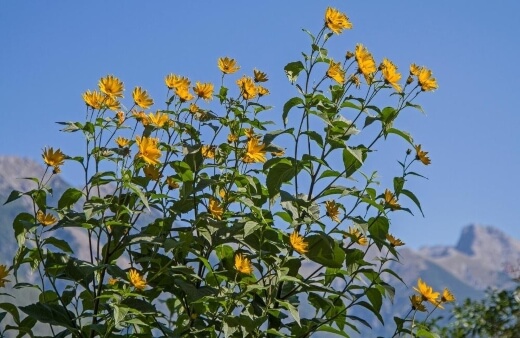
Do sunflowers come back every year?
Most sunflower varieties are annual plants, meaning that they will flower and die in a single year, but you can easily find perennial sunflowers in garden centres and online that will return year after year for a more natural look in your garden.
Can you grow sunflowers in pots?
Most sunflowers grow happily in pots, but larger varieties like Russian Giant, need plenty of space for their roots in order to support the gigantic flower heads above.
Plant dwarf sunflower varieties in pots for a striking patio display, but for taller varieties, mix good compost with your soil before planting in the ground.
Can sunflowers grow in shade?
Sunflowers can grow in shade, but they will grow tall and slender with weaker flowers that don’t last as long. Sunflowers need full sun to grow at their best and perform properly.
Can you plant sunflowers in the same place every year?
Sunflowers use up plenty of nutrients so if you plan on planting them in the same place every year, make sure to add plenty of natural materials like compost or rotted manure to add nutrients back into the soil before planting.
Looking to add more colour to your garden? Check out our complete Cosmos flowers growing and care guide.
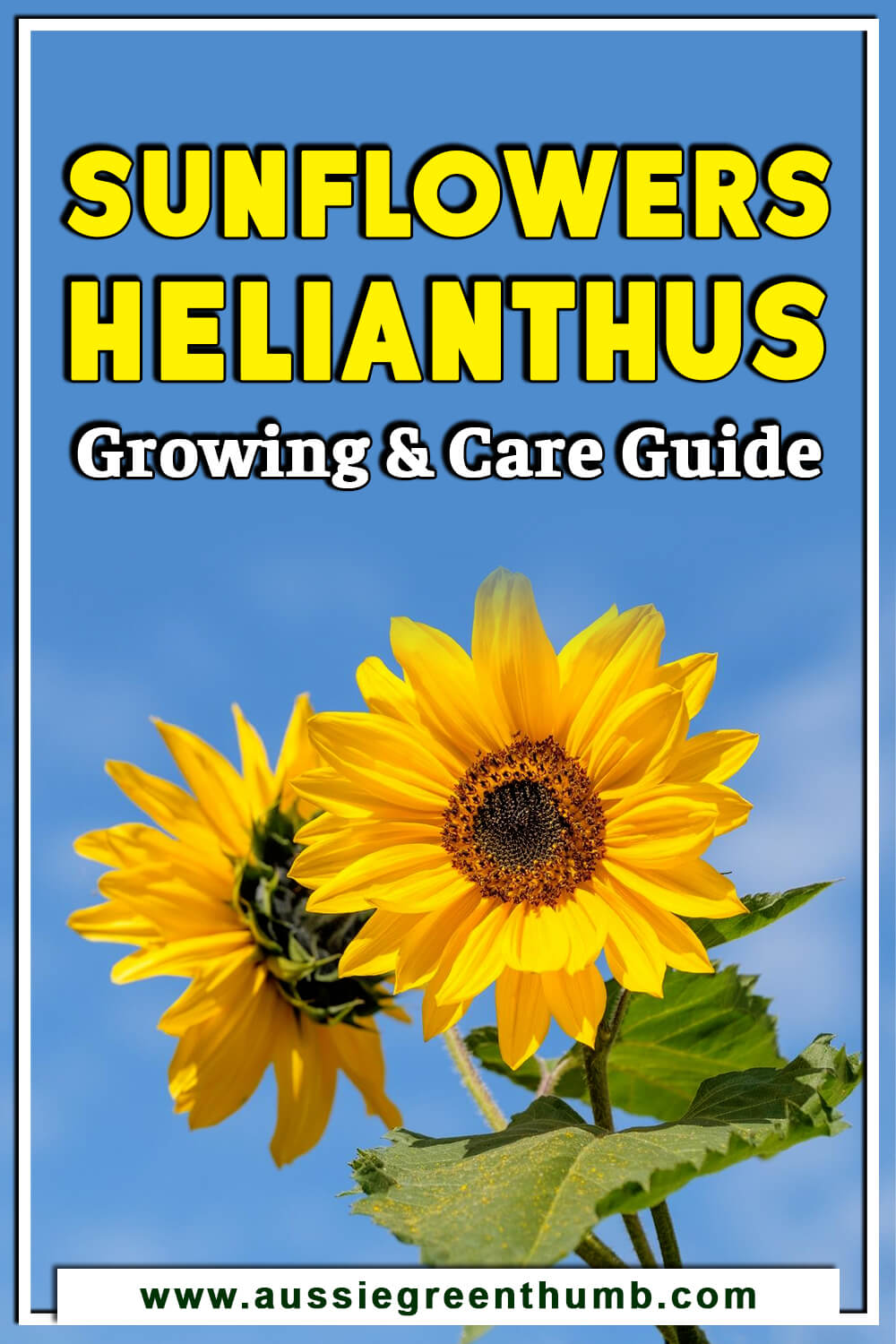
Start Growing Sunflowers in Your Garden
Whether you’re trying to get your kids into gardening, or just want that joy that takes you back to childhood yourself, sunflowers are ideal plants to get you into gardening.
There are sunflowers for every garden too, including low maintenance perennial plants, edible varieties (seeds as well as roots) and some that are just plain ridiculous, growing well over 10ft tall in the right conditions.
And now, most importantly, you know how to grow sunflowers, so get out and grow!
Published on April 30, 2022 by Maisie Blevins
Last Updated on February 21, 2024




